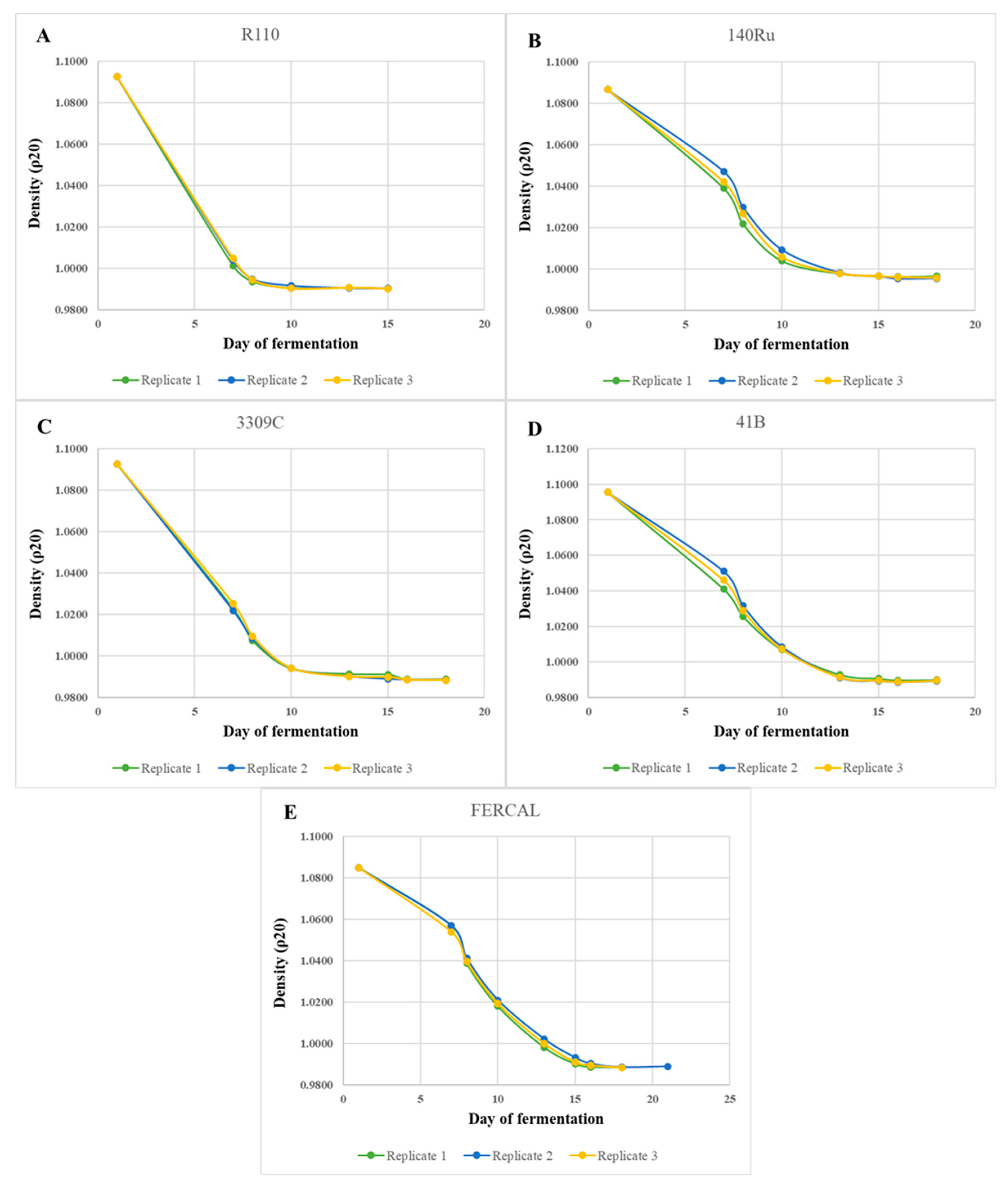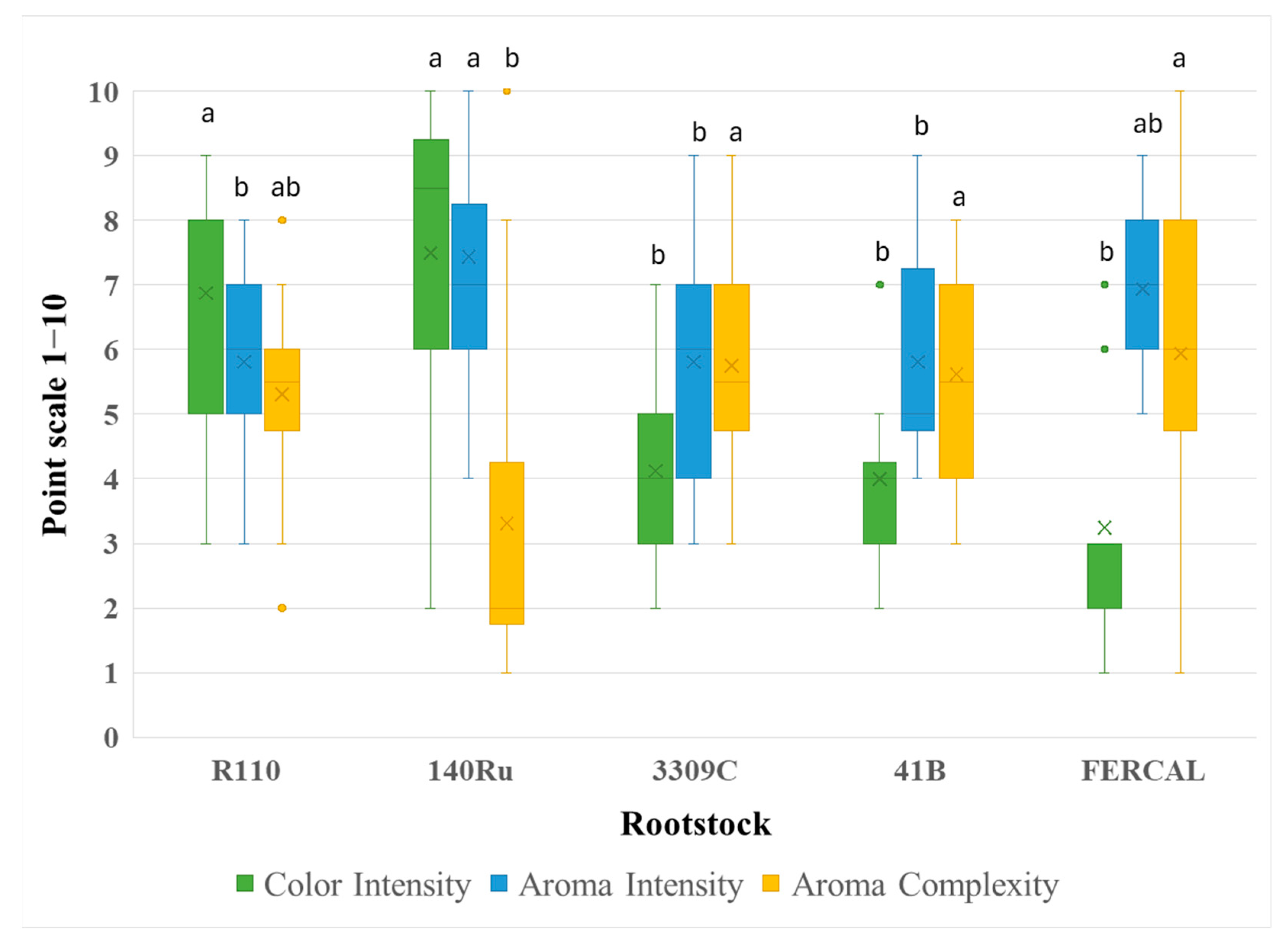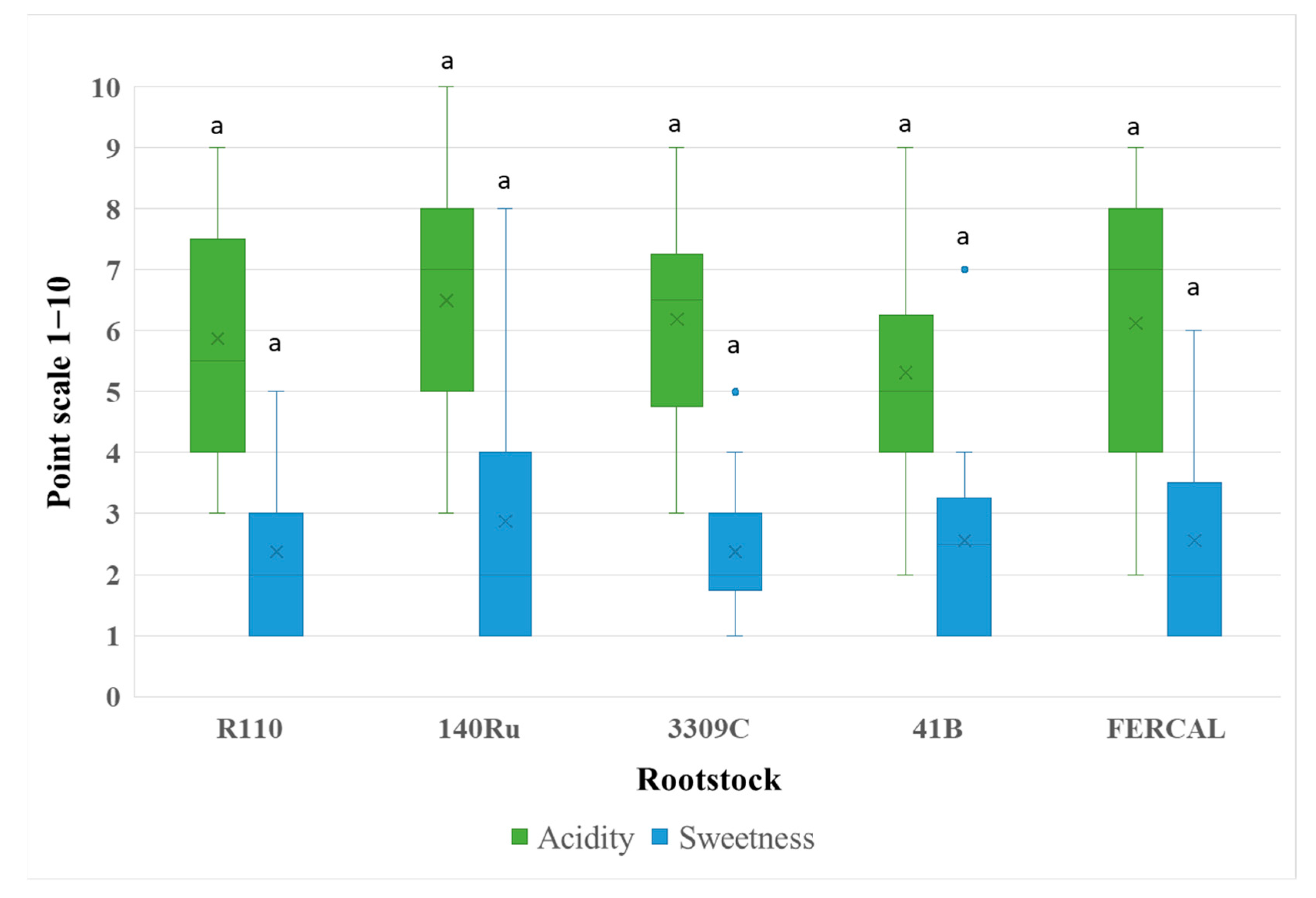Grapevine Rootstock Genotype Influences Nitrogen Levels, Must and Wine Composition, and Sensory Characteristics of Assyrtiko (Vitis vinifera L.)
Abstract
1. Introduction
2. Materials and Methods
2.1. Vineyard Site and Management—Experimental Design
2.2. Must Preparation and Micro-Vinification
2.3. Chemical Analyses
2.3.1. Classical Analyses in Musts and Wines
2.3.2. Total Tannins (TT)
2.3.3. Nitrogen Level Determination
2.4. Sensory Evaluation
2.5. Statistical Analysis
3. Results and Discussion
3.1. Chemical Composition and Nitrogen Status of Assyrtiko Must
3.2. Fermentation Duration and Kinetics
3.3. Wine Composition, Tannins, and Nitrogen Status
3.4. Sensory Profile
4. Conclusions
Author Contributions
Funding
Institutional Review Board Statement
Informed Consent Statement
Data Availability Statement
Conflicts of Interest
References
- Arnold, C.; Schnitzler, A. Ecology and Genetics of Natural Populations of North American Vitis Species Used as Rootstocks in European Grapevine Breeding Programs. Front. Plant Sci. 2020, 11, 866. [Google Scholar] [CrossRef]
- Gautier, A.; Cookson, S.J.; Lagalle, L.; Ollat, N.; Marguerit, E. Influence of the Three Main Genetic Backgrounds of Grapevine Rootstocks on Petiolar Nutrient Concentrations of the Scion, with a Focus on Phosphorus. OENO One 2020, 54, 2458. [Google Scholar] [CrossRef]
- Granett, J.; Walker, M.A.; Kocsis, L.; Omer, A.D. Biology and Management of Grape Phylloxera. Annu. Rev. Entomol. 2001, 46, 387–412. [Google Scholar] [CrossRef]
- Klimek, K.; Kapłan, M.; Najda, A. Influence of Rootstock on Yield Quantity and Quality, Contents of Biologically Active Compounds and Antioxidant Activity in Regent Grapevine Fruit. Molecules 2022, 27, 2065. [Google Scholar] [CrossRef] [PubMed]
- Ollat, N.; Peccoux, A.; Papura, D.; Esmenjaud, D.; Marguerit, E.; Tandonnet, J.P.; Delrot, S. Rootstocks as a Component of Adaptation to Environment. In Grapevine in a Changing Environment; Gerós, A., Chaves, M., Gil, H., Delrot, S., Eds.; Wiley-Blackwell: Hoboken, NJ, USA, 2016; pp. 68–108. [Google Scholar]
- Warschefsky, E.J.; Klein, L.; Frank, M.H.; Chitwood, D.H.; Londo, J.P.; von Wettberg, E.J.; Miller, A.J. Rootstocks: Diversity, Domestication, and Impacts on Shoot Phenotypes. Trends Plant Sci. 2016, 21, 418–437. [Google Scholar] [CrossRef]
- Ferris, H.; Zheng, L.; Walker, M.A. Resistance of Grape Rootstocks to Plant-Parasitic Nematodes. J. Nematol. 2012, 44, 377–386. [Google Scholar]
- Baumgartner, K.; Rizzo, D.M. Relative Resistance of Grapevine Rootstocks to Armillaria Root Disease. Am. J. Enol. Vitic. 2006, 57, 408–414. [Google Scholar] [CrossRef]
- Darriaut, R.; Lailheugue, V.; Masneuf-Pomarède, I.; Marguerit, E.; Martins, G.; Compant, S.; Ballestra, P.; Upton, S.; Ollat, N.; Lauvergeat, V. Grapevine Rootstock and Soil Microbiome Interactions: Keys for a Resilient Viticulture. Hortic. Res. 2022, 9, uhac019. [Google Scholar] [CrossRef] [PubMed]
- Liu, Z.; Zhu, C.; Sun, J.; Zhang, Z.; Zhao, S.; Shi, W.; Wang, W.; Zhao, B. Influence of Rootstock on Endogenous Hormones and Color Change in Cabernet Sauvignon Grapes. Sci. Rep. 2023, 13, 6608. [Google Scholar] [CrossRef] [PubMed]
- Harbertson, J.F.; Keller, M. Rootstock Effects on Deficit-Irrigated Winegrapes in a Dry Climate: Grape and Wine Composition. Am. J. Enol. Vitic. 2012, 63, 40–48. [Google Scholar] [CrossRef]
- Lee, J.; Skinkis, P.A. Oregon ‘Pinot Noir’ Grape Anthocyanin Enhancement by Early Leaf Removal. Food Chem. 2013, 139, 893–901. [Google Scholar] [CrossRef]
- Walker, R.R.; Blackmore, D.H.; Clingeleffer, P.R.; Correll, R.L. Rootstock effects on salt tolerance of irrigated field-grown grapevines (Vitis vinifera L. cv. Sultana): I. Yield and vigour inter-relationships. Austral. J. Grape Wine Res. 2002, 8, 3–14. [Google Scholar] [CrossRef]
- Serra, I.; Strever, A.; Myburgh, P.A.; Deloire, A. The interaction between rootstocks and cultivars (Vitis vinifera L.) to enhance drought tolerance in grapevine. Austral. J. Grape Wine Res. 2014, 20, 1–14. [Google Scholar] [CrossRef]
- Gobert, A.; Tourdot-Maréchal, R.; Sparrow, C.; Morge, C.; Alexandre, H. Influence of Nitrogen Status in Wine Alcoholic Fermentation. Food Microbiol. 2019, 83, 71–85. [Google Scholar] [CrossRef] [PubMed]
- Bell, S.J.; Henschke, P.A. Implications of Nitrogen Nutrition for Grapes, Fermentation and Wine. Aust. J. Grape Wine Res. 2005, 11, 242–295. [Google Scholar] [CrossRef]
- Godillot, J.; Sanchez, I.; Perez, M.; Picou, C.; Galeote, V.; Sablayrolles, J.M.; Farines, V.; Mouret, J.R. The Timing of Nitrogen Addition Impacts Yeast Genes Expression and the Production of Aroma Compounds during Wine Fermentation. Front. Microbiol. 2022, 13, 829786. [Google Scholar] [CrossRef]
- Keller, M.; Mills, L.J.; Harbertson, J.F. Rootstock Effects on Deficit-Irrigated Winegrapes in a Dry Climate: Vigor, Yield Formation, and Fruit Ripening. Am. J. Enol. Vitic. 2012, 63, 29–39. [Google Scholar] [CrossRef]
- Blank, M.; Tittmann, S.; Ben Ghozlen, N.; Stoll, M. Grapevine rootstocks result in differences in leaf composition (Vitis vinifera L. cv. Pinot noir) detected through non-invasive fluorescence sensor technology. Aust. J. Grape Wine Res. 2018, 24, 327–334. [Google Scholar] [CrossRef]
- Lecourt, J.; Lauvergeat, V.; Ollat, N.; Vivin, P.; Cookson, S.J. Shoot and Root Ionome Responses to Nitrate Supply in Grafted Grapevines Are Rootstock Genotype Dependent. Aust. J. Grape Wine Res. 2015, 21, 311–318. [Google Scholar] [CrossRef]
- Cochetel, N.; Escudié, F.; Cookson, S.J.; Dai, Z.; Vivin, P.; Bert, P.F.; Muñoz, M.S.; Delrot, S.; Klopp, C.; Ollat, N.; et al. Root Transcriptomic Responses of Grafted Grapevines to Heterogeneous Nitrogen Availability Depend on Rootstock Genotype. J. Exp. Bot. 2017, 68, 4339–4355. [Google Scholar] [CrossRef]
- Berdeja, M.; Hilbert, G.; Wu, D.Z.; Lafontaine, M.; Stoll, M.; Schultz, H.R.; Delrot, S. Effect of Water Stress and Rootstock Genotype on Pinot noir Berry Composition. Aust. J. Grape Wine Res. 2014, 20, 409–421. [Google Scholar] [CrossRef]
- Miele, A.; Rizzon, L.A. Rootstock-Scion Interaction: Effect on the Composition of Cabernet Sauvignon Grape Must. Rev. Bras. Frutic. 2017, 39, e-434. [Google Scholar] [CrossRef]
- Olarte Mantilla, S.M.; Collins, C.; Iland, P.G.; Kidman, C.M.; Ristic, R.; Boss, P.K.; Jordans, C.; Bastian, S.E. Shiraz (Vitis vinifera L.) Berry and Wine Sensory Profiles and Composition Are Modulated by Rootstocks. Am. J. Enol. Vitic. 2018, 69, 32–44. [Google Scholar] [CrossRef]
- Vilanova, M.; Genisheva, Z.; Tubío, M.; Álvarez, K.; Lissarrague, J.R.; Oliveira, J.M. Rootstock Effect on Volatile Composition of Albariño Wines. Appl. Sci. 2021, 11, 2135. [Google Scholar] [CrossRef]
- Karampatea, A.; Vrentzou, E.; Skendi, A.; Bouloumpasi, E. Effect of Vineyard Location on Assyrtiko Grape Ripening in Santorini and Its Wine’s Characteristics. Biol. Life Sci. Forum 2024, 40, 47. [Google Scholar] [CrossRef]
- Sgouros, G.; Mallouchos, A.; Dourou, D.; Banilas, G.; Chalvantzi, I.; Kourkoutas, Y.; Nisiotou, A. Torulaspora delbrueckii May Help Manage Total and Volatile Acidity of Santorini-Assyrtiko Wine in View of Global Warming. Foods 2023, 12, 191. [Google Scholar] [CrossRef] [PubMed]
- Blank, M.; Samer, S.; Stoll, M. Grapevine Rootstock Genotypes Influence Berry and Wine Phenolic Composition (Vitis vinifera L. cv. Pinot Noir). OENO One 2022, 56, 133–144. [Google Scholar] [CrossRef]
- OIV—International Organisation of Vine and Wine. Compendium of International Methods of Wine and Must Analysis; International Organization of Vine and Wine: Paris, France, 2009; pp. 154–196. Available online: https://www.oiv.int/ (accessed on 18 November 2024).
- Wilhelmy, C.; Pavez, C.; Bordeu, E.; Brossard, N. A Review of Tannin Determination Methods Using Spectrophotometric Detection in Red Wines and Their Ability to Predict Astringency. S. Afr. J. Enol. Vitic. 2021, 42, 1. [Google Scholar] [CrossRef]
- Duke, B.C.; Butzke, C.E. Rapid Determination of Primary Amino Acids in Grape Juice Using an o-Phthaldialdehyde/N-Acetyl-L-Cysteine Spectrophotometric Assay. Am. J. Enol. Vitic. 1998, 49, 125–134. [Google Scholar] [CrossRef]
- Corso, M.; Vannozzi, A.; Ziliotto, F.; Zouine, M.; Maza, E.; Nicolato, T.; Moser, C. Grapevine Rootstocks Differentially Affect the Rate of Ripening and Modulate Auxin-Related Genes in Cabernet Sauvignon Berries. Front. Plant Sci. 2016, 7, 69. [Google Scholar] [CrossRef]
- De Oliveira, J.B.; Laureano, O.; de Castro, R.; Pereira, G.E.; Ricardo-Da-Silva, J.M. Rootstock and harvest season affect the chemical composition and sensory analysis of grapes and wines of the Alicante Bouschet (Vitis vinifera L.) grown in a tropical semi-arid climate in Brazil. OENO One 2020, 54, 1021–1039. [Google Scholar] [CrossRef]
- Gambetta, G.A.; Manuck, C.M.; Drucker, S.T.; Shaghasi, T.; Fort, K.; Matthews, M.A.; Walker, M.A.; McElrone, A.J. The Relationship between Root Hydraulics and Scion Vigour across Vitis Rootstocks: What Role Do Root Aquaporins Play? J. Exp. Bot. 2012, 63, 6445–6455. [Google Scholar] [CrossRef]
- Lee, J.; Steenwerth, K.L. Rootstock and Vineyard Floor Management Influence on ‘Cabernet Sauvignon’ Grape Yeast Assimilable Nitrogen (YAN). Food Chem. 2011, 127, 926–933. [Google Scholar] [CrossRef]
- Verdenal, T.; Dienes-Nagy, Á.; Spangenberg, J.E.; Zufferey, V.; Spring, J.-L.; Viret, O.; Marin-Carbonne, J.; van Leeuwen, C. Understanding and Managing Nitrogen Nutrition in Grapevine: A Review. OENO One 2021, 55, 1–44. [Google Scholar] [CrossRef]
- Nikolaou, N.; Koukourikou, M.A.; Karagiannidis, N. Effects of Various Rootstocks on Xylem Exudates Cytokinin Content, Nutrient Uptake, and Growth Patterns of Grapevine Vitis vinifera L. cv. Thomson Seedless. Agronomy 2000, 20, 363–373. [Google Scholar] [CrossRef]
- Onetto, C.; McCarthy, J.; Solomon, M.; Borneman, A.R.; Schmidt, S.A. Enhancing Fermentation Performance through the Reutilisation of Wine Yeast Lees. OENO One 2024, 58, 1. [Google Scholar] [CrossRef]
- Schreiner, R.P.; Scagel, C.F.; Lee, J. N, P, and K Supply to Pinot Noir Grapevines: Impact on Berry Phenolics and Free Amino Acids. Am. J. Enol. Vitic. 2014, 65, 43–49. [Google Scholar] [CrossRef]
- Merkytė, V.; Longo, E.; Windisch, G.; Boselli, E. Phenolic Compounds as Markers of Wine Quality and Authenticity. Foods 2020, 9, 1785. [Google Scholar] [CrossRef] [PubMed]
- Kennedy, J.A.; Ferrier, J.; Harbertson, J.F.; des Gachons, C.P. Analysis of Tannins in Red Wine Using Multiple Methods: Correlation with Perceived Astringency. Am. J. Enol. Vitic. 2006, 57, 481–485. [Google Scholar] [CrossRef]
- Heller-Fuenzalida, F.; Cuneo, I.F.; Kuhn, N.; Peña-Neira, Á.; Cáceres-Mella, A. Rootstock Effect Influences the Phenolic and Sensory Characteristics of Syrah Grapes and Wines in a Mediterranean Climate. Agronomy 2023, 13, 2530. [Google Scholar] [CrossRef]
- Feifel, S.; Zimmermann, D.; Schaub, M.; Wegmann-Herr, P.; Richling, E.; Durner, D. Influence of Grape Maturity and Maceration Time on Sensory Characteristics and Phenolics in Pinot Noir and Cabernet-Sauvignon Wines. OENO One 2025, 59, 2. [Google Scholar] [CrossRef]
- Medel-Marabolí, M.; López-Solís, R.; Vásquez-Cerda, M.; Seguel-Rubio, E.; Gil-Cortiella, M.; Seguel-Seguel, O.; Obreque-Slier, E. Grapevine Rootstocks Mediate the Effects of Soil Salinity on Physicochemical and Sensory Properties of Cabernet Sauvignon Grapes and Wines. Appl. Food Res. 2025, 5, 101073. [Google Scholar] [CrossRef]





| Rootstock | °Baume | Density (g/L) | Titratable Acidity (g/L) | pH |
|---|---|---|---|---|
| R110 | 12.5 ± 0.0 c | 1.0925 ± 0.02 b | 4.70 ± 0.1 ab | 4.25 ± 0.00 a |
| 140Ru | 11.7 ± 0.0 d | 1.0866 ± 0.01 c | 4,88 ± 0.1 a | 4.13 ± 0.01 b |
| 3309C | 12.4 ± 0.0 c | 1.0927 ± 0.02 b | 4.48 ± 0.1 b | 4.07 ± 0.00 c |
| 41B | 12.6 ± 0.0 b | 1.0955 ± 0.01 a | 4.93 ± 0.2 a | 4.01 ± 0.01 d |
| FERCAL | 12.8 ± 0.0 a | 1.0950 ± 0.01 a | 4.90 ± 0.0 a | 4.07 ± 0.01 c |
| p-value | ˂0.00001 | ˂0.00001 | 0.0089 | ˂0.00001 |
| Rootstock | α-Amino Nitrogen (FAN) (mg/L) | Ammoniacal N (NH4+) (mg/L) | YAN (FAN + NH4+) (mg/L) |
|---|---|---|---|
| R110 | 128.1 ± 0.7 a | 98.7 ± 0.3 a | 226.80 ± 0.99 a |
| 140Ru | 65.3 ± 0.9 b | 67.3 ± 0.4 d | 132.60 ± 0.46 c |
| 3309C | 76.19 ± 10.0 b | 75.8 ± 2.9 c | 151.99 ± 12.87 bc |
| 41B | 77.5 ± 8.9 b | 90.7 ± 0.3 b | 122.20 ± 8.66 bc |
| FERCAL | 88.78 ± 8.53 b | 89.9 ± 1.1 b | 178.68 ± 9.63 b |
| p-value | 0.0009 | ˂0.00001 | 0.0001 |
| Rootstock | Density (g/L) | Titratable Acidity (g/L) | pH | Volatile Acidity (g/L) | Alcohol (%vol) | Reducing Sugars (g/L) | Total Tannins (g/L) |
|---|---|---|---|---|---|---|---|
| R110 | 0.9896 ± 0.01 b | 3.93 ± 0.1 c | 4.20 ± 0.00 a | 0.27 ± 0.01 c | 12.8 ± 0.0 b | 1.2 ± 0.0 abc | 0.375 ± 0.00 a |
| 140Ru | 0.9951 ± 0.01 a | 5.23 ± 0.1 a | 3.80 ± 0.00 e | 0.98 ± 0.00 a | 10.2 ± 0.1 c | 1.3 ± 0.1 ab | 0.208 ± 0.00 c |
| 3309C | 0.9883 ± 0.01 c | 3.45 ± 0.1 c | 3.90 ± 0.00 d | 0.31 ± 0.01 b | 12.7 ± 0.1 b | 1.4 ± 0.1 a | 0.292 ± 0.00 b |
| 41B | 0.9893 ± 0.02 b | 4.68 ± 0.2 ab | 3.97 ± 0.00 b | 0.23 ± 0.00 d | 12.9 ± 0.0 ab | 1.1 ± 0.0 bc | 0.167 ± 0.00 d |
| FERCAL | 0.9883 ± 0.00 c | 4.55 ± 0.1 b | 3.95 ± 0.00 c | 0.20 ± 0.01 e | 13.1 ± 0.1 a | 1.0 ± 0.1 c | 0.220 ± 0.02 c |
| p-values | ˂0.00001 | ˂0.00001 | ˂0.00001 | ˂0.00001 | ˂0.00001 | 0.0087 | ˂0.00001 |
| Rootstock | α-Amino Nitrogen (FAN) (mg/L) | Ammoniacal N (NH4+) (mg/L) | YAN (FAN + NH4+) (mg/L) |
|---|---|---|---|
| R110 | 57.73 ± 0.37 a | 4.94 ± 0.16 a | 62.67 ± 0.53 a |
| 140Ru | 41.09 ± 5.54 b | 2.51 ± 0.23 c | 43.60 ± 5.31 b |
| 3309C | 32.73 ± 2.43 bc | 3.79 ± 0.21 b | 36.52 ± 2.21 bc |
| 41B | 27.07 ± 3.86 bc | 3.62 ± 0.10 b | 30.69 ± 3.94 bc |
| FERCAL | 18.25 ± 0.83 c | 4.76 ± 0.01 a | 23.02 ± 0.83 c |
| p-value | 0.00007 | ˂0.00001 | 0.00005 |
Disclaimer/Publisher’s Note: The statements, opinions and data contained in all publications are solely those of the individual author(s) and contributor(s) and not of MDPI and/or the editor(s). MDPI and/or the editor(s) disclaim responsibility for any injury to people or property resulting from any ideas, methods, instructions or products referred to in the content. |
© 2025 by the authors. Licensee MDPI, Basel, Switzerland. This article is an open access article distributed under the terms and conditions of the Creative Commons Attribution (CC BY) license (https://creativecommons.org/licenses/by/4.0/).
Share and Cite
Beris, E.; Psarros, M.; Konstantakopoulou, V.; Evangelou, A.; Banilas, G.; Korkas, E. Grapevine Rootstock Genotype Influences Nitrogen Levels, Must and Wine Composition, and Sensory Characteristics of Assyrtiko (Vitis vinifera L.). AppliedChem 2025, 5, 27. https://doi.org/10.3390/appliedchem5040027
Beris E, Psarros M, Konstantakopoulou V, Evangelou A, Banilas G, Korkas E. Grapevine Rootstock Genotype Influences Nitrogen Levels, Must and Wine Composition, and Sensory Characteristics of Assyrtiko (Vitis vinifera L.). AppliedChem. 2025; 5(4):27. https://doi.org/10.3390/appliedchem5040027
Chicago/Turabian StyleBeris, Evangelos, Markos Psarros, Vasiliki Konstantakopoulou, Alexandra Evangelou, Georgios Banilas, and Elias Korkas. 2025. "Grapevine Rootstock Genotype Influences Nitrogen Levels, Must and Wine Composition, and Sensory Characteristics of Assyrtiko (Vitis vinifera L.)" AppliedChem 5, no. 4: 27. https://doi.org/10.3390/appliedchem5040027
APA StyleBeris, E., Psarros, M., Konstantakopoulou, V., Evangelou, A., Banilas, G., & Korkas, E. (2025). Grapevine Rootstock Genotype Influences Nitrogen Levels, Must and Wine Composition, and Sensory Characteristics of Assyrtiko (Vitis vinifera L.). AppliedChem, 5(4), 27. https://doi.org/10.3390/appliedchem5040027







